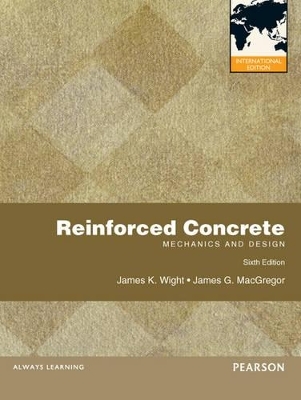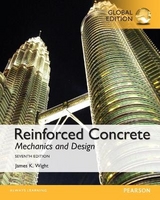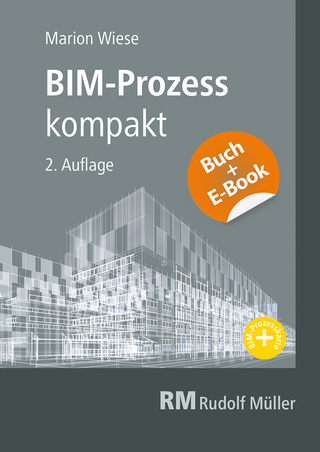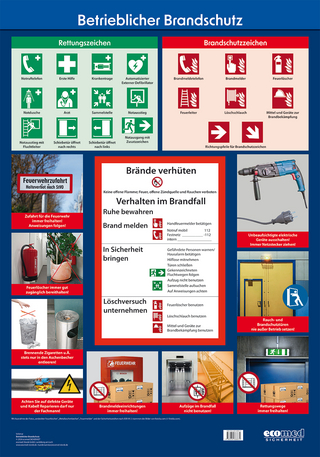
Reinforced Concrete: Mechanics and Design
Pearson Education
978-0-273-76454-0 (ISBN)
- Titel erscheint in neuer Auflage
- Artikel merken
PREFACE xi
ABOUT THE AUTHORS xv
CHAPTER 1 INTRODUCTION
1-1 Reinforced Concrete Structures
1-2 Mechanics of Reinforced Concrete
1-3 Reinforced Concrete Members
1-4 Factors Affecting Choice of Reinforced Concrete for a Structure
1-5 Historical Development of Concrete and Reinforced Concrete as Structural Materials
1-6 Building Codes and the ACI Code
CHAPTER 2 THE DESIGN PROCESS
2-1 Objectives of Design
2-2 The Design Process
2-3 Limit States and the Design of Reinforced Concrete
2-4 Structural Safety
2-5 Probabilistic Calculation of Safety Factors
2-6 Design Procedures Specified in the ACI Building Code
2-7 Load Factors and Load Combinations in the 2011 ACI Code
2-8 Loadings and Actions
2-9 Design for Economy
2-10 Sustainability
2-11 Customary Dimensions and Construction Tolerances
2-12 Inspection
2-13 Accuracy of Calculations
2-14 Handbooks and Design Aids
CHAPTER 3 MATERIALS
3-1 Concrete
3-2 Behavior of Concrete Failing in Compression
3-3 Compressive Strength of Concrete
3-4 Strength Under Tensile and Multiaxial Loads
3-5 Stress Strain Curves for Concrete
3-6 Time-Dependent Volume Changes
3-7 High-Strength Concrete
3-8 Lightweight Concrete
3-9 Fiber Reinforced Concrete
3-10 Durability of Concrete
3-11 Behavior of Concrete Exposed to High and Low Temperatures
3-12 Shotcrete
3-13 High-Alumina Cement
3-14 Reinforcement
3-15 Fiber-Reinforced Polymer (FRP) Reinforcement
3-16 Prestressing Steel
CHAPTER 4 FLEXURE: BEHAVIOR AND NOMINAL STRENGTH OF BEAM SECTIONS
4-1 Introduction
4-2 Flexure Theory
4-3 Simplifications in Flexure Theory for Design
4-4 Analysis of Nominal Moment Strength for Singly Reinforced Beam Sections
4-5 Definition of Balanced Conditions
4-6 Code Definitions of Tension-Controlled and Compression-Controlled Sections
4-7 Beams with Compression Reinforcement
4-8 Analysis of Flanged Sections
4-9 Unsymmetrical Beam Sections
CHAPTER 5 FLEXURAL DESIGN OF BEAM SECTIONS
5-1 Introduction
5-2 Analysis of Continuous One-Way Floor Systems
5-3 Design of Singly-Reinforced Beam Sections with Rectangular Compression Zones
5-4 Design of Doubly-Reinforced Beam Sections
5-5 Design of Continuous One-Way Slabs
CHAPTER 6 SHEAR IN BEAMS
6-1 Introduction
6-2 Basic Theory
6-3 Behavior of Beams Failing in Shear
6-4 Truss Model of the Behavior of Slender Beams Failing in Shear
6-5 Analysis and Design of Reinforced Concrete Beams for Shear ACI Code
6-6 Other Shear Design Methods
6-7 Hanger Reinforcement
6-8 Tapered Beams
6-9 Shear in Axially Loaded Members
6-10 Shear in Seismic Regions
CHAPTER 7 TORSION
7-1 Introduction and Basic Theory
7-2 Behavior of Reinforced Concrete Members Subjected to Torsion
7-3 Design Methods for Torsion
7-4 Thin-Walled Tube/Plastic Space Truss Design Method
7-5 Design for Torsion and Shear ACI Code
7-6 Application of ACI Code Design Method for Torsion
CHAPTER 8 DEVELOPMENT, ANCHORAGE, AND SPLICING OF REINFORCEMENT
8-1 Introduction
8-2 Mechanism of Bond Transfer
8-3 Development Length
8-4 Hooked Anchorages
8-5 Headed and Mechanically Anchored Bars in Tension
8-6 Design for Anchorage
8-7 Bar Cutoffs and Development of Bars in Flexural Members
8-8 Reinforcement Continuity and Structural Integrity Requirements
8-9 Splices
CHAPTER 9 SERVICEABILITY
9-1 Introduction
9-2 Elastic Analysis of Stresses in Beam Sections
9-3 Cracking
9-4 Deflections of Concrete Beams
9-5 Consideration of Deflections in Design
9-6 Frame Deflections
9-7 Vibrations
9-8 Fatigue
CHAPTER 10 CONTINUOUS BEAMS AND ONE-WAY SLABS
10-1 Introduction
10-2 Continuity in Reinforced Concrete Structures
10-3 Continuous Beams
10-4 Design of Girders
10-5 Joist Floors
10-6 Moment Redistribution
CHAPTER 11 COLUMNS: COMBINED AXIAL LOAD AND BENDING
11-1 Introduction
11-2 Tied and Spiral Columns
11-3 Interaction Diagrams
11-4 Interaction Diagrams for Reinforced Concrete Columns
11-5 Design of Short Columns
11-6 Contributions of Steel and Concrete to Column Strength
11-7 Biaxially Loaded Columns
CHAPTER 12 SLENDER COLUMNS
12-1 Introduction
12-2 Behavior and Analysis of Pin-Ended Columns
12-3 Behavior of Restrained Columns in Nonsway Frames
12-4 Design of Columns in Nonsway Frames
12-5 Behavior of Restrained Columns in Sway Frames
12-6 Calculation of Moments in Sway Frames Using Second-Order Analyses
12-7 Design of Columns in Sway Frames
12-8 General Analysis of Slenderness Effects
12-9 Torsional Critical Load
CHAPTER 13 TWO-WAY SLABS: BEHAVIOR, ANALYSIS, AND DESIGN
13-1 Introduction
13-2 History of Two-Way Slabs
13-3 Behavior of Slabs Loaded to Failure in Flexure
13-4 Analysis of Moments in Two-Way Slabs
13-5 Distribution of Moments in Slabs
13-6 Design of Slabs
13-7 The Direct-Design Method
13-8 Equivalent-Frame Methods
13-9 Use of Computers for an Equivalent-Frame Analysis
13-10 Shear Strength of Two-Way Slabs
13-11 Combined Shear and Moment Transfer in Two-Way Slabs
13-12 Details and Reinforcement Requirements
13-13 Design of Slabs Without Beams
13-14 Design of Slabs with Beams in Two Directions
13-15 Construction Loads on Slabs
13-16 Deflections in Two-Way Slab Systems
13-17 Use of Post-Tensioning
CHAPTER 14 TWO-WAY SLABS: ELASTIC AND YIELD-LINE ANALYSES
14-1 Review of Elastic Analysis of Slabs
14-2 Design Moments from a Finite-Element Analysis
14-3 Yield-Line Analysis of Slabs: Introduction
14-4 Yield-Line Analysis: Applications for Two-Way Slab Panels
14-5 Yield-Line Patterns at Discontinuous Corners
14-6 Yield-Line Patterns at Columns or at Concentrated Loads
CHAPTER 15 FOOTINGS
15-1 Introduction
15-2 Soil Pressure Under Footings
15-3 Structural Action of Strip and Spread Footings
15-4 Strip or Wall Footings
15-5 Spread Footings
15-6 Combined Footings
15-7 Mat Foundations
15-8 Pile Caps
CHAPTER 16 SHEAR FRICTION, HORIZONTAL SHEAR TRANSFER, AND COMPOSITE CONCRETE BEAMS
16-1 Introduction
16-2 Shear Friction
16-3 Composite Concrete Beams
CHAPTER 17 DISCONTINUITY REGIONS AND STRUT-AND-TIE MODELS
17-1 Introduction
17-2 Design Equation and Method of Solution
17-3 Struts
17-4 Ties
17-5 Nodes and Nodal Zones
17-6 Common Strut-and-Tie Models
17-7 Layout of Strut-and-Tie Models
17-8 Deep Beams
17-9 Continuous Deep Beams
17-10 Brackets and Corbels
17-11 Dapped Ends
17-12 Beam Column Joints
17-13 Bearing Strength
17-14 T-Beam Flanges
CHAPTER 18 WALLS AND SHEAR WALLS
18-1 Introduction
18-2 Bearing Walls
18-3 Retaining Walls
18-4 Tilt-Up Walls
18-5 Shear Walls
18-6 Lateral Load-Resisting Systems for Buildings
18-7 Shear Wall Frame Interaction
18-8 Coupled Shear Walls
18-9 Design of Structural Walls General
18-10 Flexural Strength of Shear Walls
18-11 Shear Strength of Shear Walls
18-12 Critical Loads for Axially Loaded Walls
CHAPTER 19 DESIGN FOR EARTHQUAKE RESISTANCE
19-1 Introduction
19-2 Seismic Response Spectra
19-3 Seismic Design Requirements
19-4 Seismic Forces on Structures
19-5 Ductility of Reinforced Concrete Members
19-6 General ACI Code Provisions for Seismic Design
19-7 Flexural Members in Special Moment Frames
19-8 Columns in Special Moment Frames
19-9 Joints of Special Moment Frames
19-10 Structural Diaphragms
19-11 Structural Walls
19-12 Frame Members not Proportioned to Resist Forces Induced by Earthquake Motions
19-13 Special Precast Structures
19-14 Foundations
APPENDIX A
APPENDIX B
INDEX
| Sprache | englisch |
|---|---|
| Maße | 205 x 251 mm |
| Gewicht | 2040 g |
| Themenwelt | Schulbuch / Wörterbuch |
| Technik ► Bauwesen | |
| ISBN-10 | 0-273-76454-3 / 0273764543 |
| ISBN-13 | 978-0-273-76454-0 / 9780273764540 |
| Zustand | Neuware |
| Haben Sie eine Frage zum Produkt? |
aus dem Bereich



